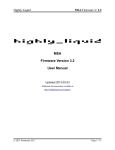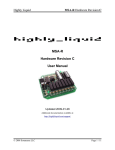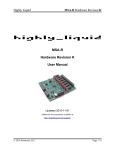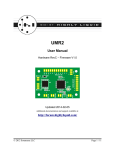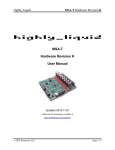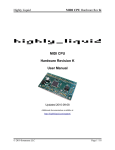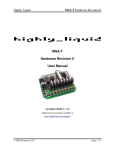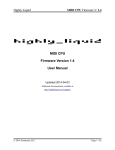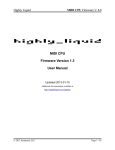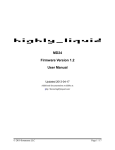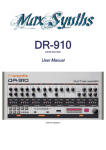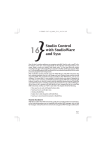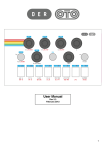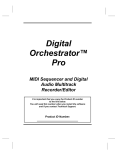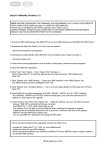Download MSA Firmware Version 3.1 User Manual
Transcript
Highly Liquid MSA Firmware V. 3.1 MSA Firmware Version 3.1 User Manual Updated 2010-12-09 Additional documentation available at: http://highlyliquid.com/support/ © 2010 Sonarcana LLC Page 1 / 14 Highly Liquid MSA Firmware V. 3.1 Table of Contents 1.0 Overview..............................................................................................................3 1.1 About The MSA....................................................................................................................3 1.2 About This Document............................................................................................................3 1.3 Additional Resources.............................................................................................................3 2.0 Individual Output Operation..................................................................................4 2.1 Learn Method.......................................................................................................................4 2.2 SysEx Method.......................................................................................................................5 2.2.1 Output Mode (mm) and Data (d0, d1).......................................................................................................5 2.2.2 Pulse Length (ph, pl)..................................................................................................................................5 3.0 Preset Operation...................................................................................................7 3.1 Learn Method.......................................................................................................................7 3.2 SysEx Method.......................................................................................................................8 3.2.1 Recall Type (rr)..........................................................................................................................................8 3.2.2 Preset State (nn, s0-s7)...............................................................................................................................8 4.0 Factory Default Configuration...............................................................................9 5.0 Configuration Retrieval.......................................................................................10 5.1 Identity Request / Identity Reply.........................................................................................10 5.2 Output Configuration Retrieval..........................................................................................11 6.0 DIP Switch..........................................................................................................12 6.1 MIDI Channel.....................................................................................................................12 6.2 Unit ID................................................................................................................................12 7.0 Activity LED.......................................................................................................13 8.0 Firmware Update................................................................................................14 8.1 Firmware Update Procedure...............................................................................................14 8.2 Notes...................................................................................................................................14 © 2010 Sonarcana LLC Page 2 / 14 Highly Liquid MSA Firmware V. 3.1 1.0 Overview Users are encouraged to read MSA Hardware User Manual before continuing with this document. 1.1 About The MSA The MSA is a multipurpose MIDI decoder. It can activate its 8 outputs in response to incoming MIDI messages of virtually any type. The MSA has two basic types of operation. At any time, the MSA can be configured for only one of the following: • Individual Output Operation: Each MSA output responds independently to MIDI input. • Preset Operation: The MSA stores up to 128 “presets”, each consisting of an 8-output state. Presets are recalled using program change, CC, or note commands. To specify the desired behavior for either of the above operation types, the user can employ one of two configuration methods: • “Learn” Method: MSA behavior is specified via a mixture of switch input and MIDI messages. • SysEx Method: MIDI System Exclusive (SysEx) messages are used to specify MSA behavior. MSA configuration is retained when the MSA is disconnected from a power supply. The MSA ships with a “factory default” configuration which can be described in terms of equivalent SysEx messages. See Factory Default Configuration. 1.2 About This Document Throughout this document, SysEx message contents are shown in hexadecimal format. Hexadecimal numbers either are described as “hex” or are followed by the 'h' suffix. Decimal format should be assumed for all other numbers. Sections of the manual that have changed significantly since the previous firmware version are highlighted in yellow. 1.3 Additional Resources Instructions for using a PC to create and send SysEx messages can be found at: http://highlyliquid.com/support/library/midi-sysex.html Support inquiries should be posted at the Highly Liquid support forums. Project examples and other information are posted at the forums: http://forum.highlyliquid.com/ © 2010 Sonarcana LLC Page 3 / 14 Highly Liquid MSA Firmware V. 3.1 2.0 Individual Output Operation When the MSA is configured for Individual Output Operation, each MSA output responds independently to a specific MIDI message. Configure the MIDI response of each output via the Learn Method or SysEx Method. 2.1 Learn Method A user-supplied “program” (PRGM) switch must be attached to the MSA “PRGM” terminals. If no switch is available, a piece of wire can be used to temporarily connect the terminals. See MSA Hardware User Manual for wiring details. Use the following procedure to configure the MSA: 1. Set the MSA DIP Switch for the desired MIDI channel. 2. Connect power to the MSA while pressing the PRGM switch. 3. Release the PRGM switch. The activity LED will blink slowly to indicate that the MSA is ready to learn. 4. Send a series of 8 MIDI messages to the MSA MIDI In port. As each message is received, the MSA output being assigned to the message will temporarily activate. Allow each output to deactivate before proceeding with the next message. 5. After the 8th message is received, the configuration is stored. To resume normal operation, disconnect, then reconnect power to the MSA. Table 2-a shows the MIDI message types that can be learned. A single message type or a mixture of message types can be used. If different output modes are desired, the SysEx Method method must be used. Table 2-a: Output Configuration by Message Type MIDI Message Type Resulting Configuration Note Note Trigger CC CC On/Off Program Change Program Change “Match Only” If the MSA does not receive 8 qualifying messages, any partially learned configuration will be discarded, and the prior configuration will remain. The learn method can be repeated as desired to change the MSA configuration. Configuration is retained when the MSA is disconnected from a power supply. © 2010 Sonarcana LLC Page 4 / 14 Highly Liquid MSA Firmware V. 3.1 2.2 SysEx Method Figure 2-1 shows the format of the Individual Output Configuration SysEx Message. The message is a string of exactly 34 bytes. The body of the message consists of a Unit ID, a 3-byte configuration for each of the 8 MSA outputs, and a 2-byte pulse length. Upon success, the MSA activity LED blinks 3 times and Individual Output Operation begins. Figure 2-1: Individual Output Configuration SysEx Message Section Format (Hex) Fixed Header F0 00 01 5D 05 01 Unit ID id Output 0 Configuration mm d0 d1 Output 1 Configuration mm d0 d1 Output 2 Configuration mm d0 d1 Output 3 Configuration mm d0 d1 Output 4 Configuration mm d0 d1 Output 5 Configuration mm d0 d1 Output 6 Configuration mm d0 d1 Output 7 Configuration mm d0 d1 Pulse Length ph pl Fixed Footer F7 2.2.1 Output Mode (mm) and Data (d0, d1) Parameter mm specifies the output mode for the corresponding MSA output. For “normal” modes, the output is “off” by default and is activated in response to incoming MIDI events. For “inverted” modes, the output is “on” by default with an inverted MIDI response. The meaning of bytes d0 and d1 depend on the value of mm. Output modes are described in Table 2-b. 2.2.2 Pulse Length (ph, pl) Certain output modes generate fixed-length output pulses. The length of the output pulse is set “globally” via the values ph and pl, according to the following formula: pulse length = ((ph × 128) + pl + 1) × 0.5 ms The valid range for both ph and pl is 00h–7Fh. Thus, the maximum configurable pulse length is approximately 8.2 seconds. Actual pulse length is accurate to 0.5 ms of configured value. Output modes which do not generate fixed-length pulses are not affected by the values ph and pl. © 2010 Sonarcana LLC Page 5 / 14 Highly Liquid MSA Firmware V. 3.1 Table 2-b: Output Modes mm (Hex) Mode Description d0 Meaning d1 Meaning Ignored Ignored Note Trigger Output is “on” for the duration of the corresponding MIDI note with velocity greater than or equal to d1. Note Number Velocity Threshold 42 Note Trigger – Fixed Length Pulse Matching note on messages with a velocity equal to or greater than d1generate a pulse with length determined by the values of ph and pl. Note Number Velocity Threshold 43 Note Toggle Output state is toggled & latched upon the receipt of a matching Note On message. Note Number Velocity Threshold 48 CC On/Off Matching CC messages with a value equal to or greater than d1 latch output “on”. Matching CC messages with a value less than d1 latch output “off”. CC Number Value Threshold 49 CC – Fixed Length Pulse Matching CC messages with a value equal to or greater than d1generate a pulse with length determined by the values of ph and pl. CC Number Value Threshold 0A 4A CC Toggle Output is toggled & latched upon the receipt of matching CC messages with a value equal to or greater than d1. CC Number Value Threshold 0B 4B CC “Match Only” Output is latched “on” when a matching CC message is received. All other CC messages latch output “off”. CC Number Ignored 10 50 Program Change “Match Only” Output is latched “on” when a matching program change message is received. All other program change messages latch output “off”. Program Number Ignored 11 51 Program Change – Fixed Length Pulse Matching program change messages generate a pulse with length determined by the values ph and pl. Program Number Ignored 18 58 Sync – Run Output is latched “on” by MIDI Start or MIDI Continue messages, and is latched “off” by MIDI Stop messages. Ignored Ignored 19 59 Sync – Clock MIDI Clock messages generate pulses with length determined by ph and pl. Ignored Ignored Normal Inverted 00 40 Disabled Output does not respond to MIDI input. 01 41 02 03 08 09 © 2010 Sonarcana LLC Page 6 / 14 Highly Liquid MSA Firmware V. 3.1 3.0 Preset Operation The MSA stores up to 128 “presets”, each consisting of an 8-output state. Presets are recalled using program change, CC, or note commands. Configure the MIDI response of each output via the Learn Method or SysEx Method. 3.1 Learn Method A user-supplied “program” (PRGM) switch must be attached to the MSA “PRGM” terminals. If no switch is available, a piece of wire can be used to temporarily connect the terminals. See MSA Hardware User Manual for wiring details. Use the following procedure to configure the MSA: 1. Connect power to the MSA. Allow the activity LED self-test to complete. 2. Press, then release the PRGM switch. The activity LED will blink twice to indicate that the MSA is ready to learn. 3. While learning, the MSA will listen for MIDI Program Change, CC, and Note messages on all channels. 4. Send the MSA a MIDI message corresponding to the preset to be learned. The MSA outputs will be updated to reflect the existing preset state. 5. Set DIP switch positions 1-4 to correspond to the desired MSA output states 0-3 for this preset. 6. Press and release the PRGM switch. The MSA will set outputs 0-3 as directed in step 5. 7. Set the DIP switch positions 1-4 to correspond to the desired MSA output states 4-7 for this preset. 8. Press and release the PRGM switch. The MSA will set all outputs as directed in steps 5 and 7, and store the output state to the selected preset. 9. Repeat steps 4-8 as desired. 10. To resume normal operation, disconnect, then reconnect power to the MSA. Important Notes: 1. During normal operation, the MSA will respond only to MIDI messages on the channel specified by the DIP Switch. Be sure to return the DIP switch to the desired channel setting after the learn procedure. 2. The MSA will remember the message type (Program Change, CC, or Note) used during the learning process. The same message type must be used to recall presets during normal operation. © 2010 Sonarcana LLC Page 7 / 14 Highly Liquid MSA Firmware V. 3.1 3.2 SysEx Method Figure 3-1 shows the format of the Preset Configuration SysEx Message. The message consists of a fixed header, Unit ID, and recall type, followed by one or more 9-byte preset states. Upon success, the MSA activity LED blinks 3 times and Preset Operation begins. Figure 3-1: Preset Configuration SysEx Message Section Format (Hex) Fixed Header F0 00 01 5D 05 02 Unit ID id Recall Type rr Preset State nn s0 s1 s2 s3 s4 s5 s6 s7 Preset State (Optional) nn s0 s1 s2 s3 s4 s5 s6 s7 Preset State (Optional) nn s0 s1 s2 s3 s4 s5 s6 s7 . . . . . . Preset State (Optional) nn s0 s1 s2 s3 s4 s5 s6 s7 Fixed Footer F7 3.2.1 Recall Type (rr) Byte rr specifies which type of MIDI message will be used to recall the presets during operation. See Table 3-a. Table 3-a: Recall Types rr (Hex) Recall Type 01 Program Change 02 CC 04 Note 3.2.2 Preset State (nn, s0-s7) Byte nn specifies the number of the preset defined by the following 8 bytes. nn corresponds to the MIDI program, CC, or note number used to recall the preset. The MSA can store up to 128 presets. The valid range for nn is 00h-7Fh. Byte s0-s7 specify the states of MSA outputs 0-7. For these bytes, a value of 00h sets the output to off, and a value of 01h sets the value to on. © 2010 Sonarcana LLC Page 8 / 14 Highly Liquid MSA Firmware V. 3.1 4.0 Factory Default Configuration By default, the MSA operates in Individual Output Operation. MSA outputs 0-7 respond to MIDI notes 60-67. The default configuration can be described by an Independent Output Configuration SysEx Message as shown in Figure 4-1. Figure 4-1: Factory Default Configuration SysEx Message SysEx Data (Hex) Meaning F0 00 01 5D 05 01 Fixed header 00 Unit ID (00h = All Units) 01 3C 01 Output 0 configuration 01 3D 01 Output 1 configuration 01 3E 01 Output 2 configuration 01 3F 01 Output 3 configuration 01 40 01 Output 4 configuration 01 41 01 Output 5 configuration 01 42 01 Output 6 configuration 01 43 01 Output 7 configuration 07 67 F7 © 2010 Sonarcana LLC Pulse length: 500ms (Not used by factory default output modes.) Fixed Footer Page 9 / 14 Highly Liquid MSA Firmware V. 3.1 5.0 Configuration Retrieval 5.1 Identity Request / Identity Reply The MSA responds to the standard “Identity Request” SysEx command. If the MSA receives the SysEx message described in Figure 5-1, it will respond with the standard “Identity Reply” message described in Figure 5-2. Figure 5-1: Identity Request SysEx Message SysEx Data (Hex) Meaning F0 7E 7F 06 01 F7 Fixed Message Figure 5-2: Identity Reply SysEx Message SysEx Data (Hex) Meaning F0 7E 7F 06 02 Fixed Header 00 01 5D Manufacturer ID 00 00 Family Code (MIDI Decoder) 00 05 Model (MSA Rev K) 00 vv Version, where vv is the firmware version number as described in Table 5-a. id Unit ID tt Configured Operation Type. tt = 01h for Individual Output Operation. tt = 02h for Preset Operation. F7 Fixed Footer Table 5-a: Firmware Version © 2010 Sonarcana LLC vv (Hex) Firmware Version 00 3.0 01 3.1 02 thru 7F Reserved for future versions. Page 10 / 14 Highly Liquid MSA Firmware V. 3.1 5.2 Output Configuration Retrieval The current MSA configuration can be retrieved via the MSA MIDI Out port. If the MSA receives a SysEx message as described in Figure 5-3, it will send its configuration as an Individual Output Configuration SysEx Message. If the MSA receives a SysEx message as described in Figure 5-4 or Figure 5-5, it will send its configuration as a Preset Configuration SysEx Message. Figure 5-3: Individual Output Configuration Request SysEx Message SysEx Data (Hex) Meaning F0 00 01 5D 05 00 00 01 F7 Fixed Message Figure 5-4: Preset Request (Single Preset) SysEx Message SysEx Data (Hex) F0 00 01 5D 05 00 00 02 Meaning Fixed Header pp Preset # F7 Fixed Footer Figure 5-5: Preset Request (128-Preset Dump) SysEx Message SysEx Data (Hex) Meaning F0 00 01 5D 05 00 00 04 F7 Fixed Message © 2010 Sonarcana LLC Page 11 / 14 Highly Liquid MSA Firmware V. 3.1 6.0 DIP Switch The MSA DIP switch serves two main purposes: to set the MIDI channel for MIDI input, and to set the “Unit ID”. See Table 6-a. 6.1 MIDI Channel The MSA DIP switch is used to specify the MIDI channel for incoming MIDI messages. During normal operation, the MSA will respond only to messages received on this channel. 6.2 Unit ID Each configuration SysEx message contains a Unit ID byte. If the Unit ID byte is 00h, any MSA unit receiving the message will configure itself as directed by the message. If the Unit ID byte is between 1 and 16 (01h to 10h), any MSA receiving the message will update its configuration only if its DIP Switch setting matches the Unit ID. This allows the user to target & configure a single MSA within a chain of multiple units. Table 6-a: MIDI Channel / Unit ID DIP Switch Settings © 2010 Sonarcana LLC MIDI Channel / Unit ID SW1 Setting 1 2 3 4 1 off off off off 2 off off off on 3 off off on off 4 off off on on 5 off on off off 6 off on off on 7 off on on off 8 off on on on 9 on off off off 10 on off off on 11 on off on off 12 on off on on 13 on on off off 14 on on off on 15 on on on off 16 on on on on Page 12 / 14 Highly Liquid MSA Firmware V. 3.1 7.0 Activity LED The MSA activity LED performs several functions: ● Self Test: Upon power-up or device reset, the activity LED lights briefly before normal operation begins. ● Configuration Update Indication: When the MSA configuration is updated via a MIDI SysEx message, the MSA will reset, followed by the LED self-test. If no LED activity is observed, then the attempted configuration was unsuccessful. ● MIDI Activity Indication: The LED blinks when a MIDI message is received that affects the MSA output state. Other MIDI messages will not cause an activity indication. ● Learn Mode Indication: The LED will blink slowly while the MSA awaits MIDI messages during Learn Mode. ● Firmware Update Error: The LED blinks continuously when the receipt of a firmware update SysEx message has failed, or when the firmware has become corrupt. © 2010 Sonarcana LLC Page 13 / 14 Highly Liquid MSA Firmware V. 3.1 8.0 Firmware Update MSA firmware can be upgraded via MIDI SysEx message. Firmware update files, when available, can be downloaded from the MSA product page at highlyliquid.com. 8.1 Firmware Update Procedure 1. Download and unzip the firmware update SysEx message. The resulting file should have the extension “.syx”. 2. Disconnect power to the MSA. 3. Press and hold the PRGM switch. (See MSA Hardware User Manual.) 4. Reconnect power to the MSA. The activity LED will remain lighted. 5. Send the firmware update SysEx message to the MSA. Transmission of the message may require several seconds. 6. Upon completion of the update, the activity LED will deactivate. 7. Release the PRGM switch. 8. Disconnect power to the MSA. 8.2 Notes • Do not interrupt the transmission of the firmware update SysEx message. • A continuously blinking activity LED indicates an error in the transmission of the firmware update SysEx message. • If a continuously blinking activity LED is observed, repeat the procedure from the beginning. • The current firmware version can be retrieved via Identity Request / Identity Reply SysEx messages. © 2010 Sonarcana LLC Page 14 / 14















